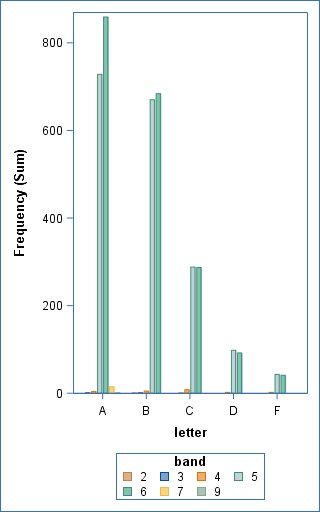- Home
- /
- Programming
- /
- SAS Procedures
- /
- PROC CHART?
- RSS Feed
- Mark Topic as New
- Mark Topic as Read
- Float this Topic for Current User
- Bookmark
- Subscribe
- Mute
- Printer Friendly Page
- Mark as New
- Bookmark
- Subscribe
- Mute
- RSS Feed
- Permalink
- Report Inappropriate Content
Here's a sample of the data I have:
letter band
A 4
B 3
A 7
C 2
C 7
D 1
F 8
A 10
I want 5 vertical stacked bar graphs. Each bar (A,B,C,D,F) will have 10 subcategories (1 - 10) that shows the frequency of each band in each letter category (A - F)
Accepted Solutions
- Mark as New
- Bookmark
- Subscribe
- Mute
- RSS Feed
- Permalink
- Report Inappropriate Content
Here are some options for you.
ods graphics / height=1000 width=500;
proc sgplot data=work.comm;
vbar letter / response=frequency stat=sum group=band
groupdisplay=stack grouporder=ascending barwidth=.5;
run;
/* cluster instead of stack */
ods graphics / height=800 width=500;
proc sgplot data=work.comm;
vbar letter / response=frequency stat=sum group=band
groupdisplay=cluster grouporder=ascending barwidth=.7;
run;
/* Horizontal to go for a wide view */
ods graphics / width=1200 height=500;
proc sgplot data=work.comm;
hbar letter / response=frequency stat=sum group=band
groupdisplay=stack grouporder=ascending barwidth=.5;
run;
VBAR example
VBAR with GROUPDISPLAY=CLUSTER
HBAR example, stacked
- Mark as New
- Bookmark
- Subscribe
- Mute
- RSS Feed
- Permalink
- Report Inappropriate Content
I think you want to look at PROC SGPLOT and the VBAR statement. Use Group= and GroupDisplay=Stack. Examples here in this blog post.
- Mark as New
- Bookmark
- Subscribe
- Mute
- RSS Feed
- Permalink
- Report Inappropriate Content
Maybe i'm on the wrong track. I want a visual for the chart below. Letter has 5 values (A B C D F). I want to show that the relative size of each band, i.e. bands 5 and 6 represent the vast majority. (as is the case with the other letters)
| letter | band | Frequency | Percent | Cumulative Frequency |
Cumulative Percent |
|---|---|---|---|---|---|
| A | 3 | 1 | 0.03 | 1 | 0.03 |
| A | 4 | 4 | 0.10 | 5 | 0.13 |
| A | 5 | 728 | 19.00 | 733 | 19.13 |
| A | 6 | 859 | 22.42 | 1592 | 41.56 |
| A | 7 | 15 | 0.39 | 1607 | 41.95 |
| A | 9 | 1 | 0.03 | 1608 | 41.97 |
| B | 2 | 1 | 0.03 | 1609 | 42.00 |
| B | 3 | 1 | 0.03 | 1610 | 42.03 |
| B | 4 | 5 | 0.13 | 1615 | 42.16 |
| B | 5 | 670 | 17.49 | 2285 | 59.65 |
| B | 6 | 684 | 17.85 | 2969 | 77.50 |
| C | 2 | 1 | 0.03 | 2970 | 77.53 |
| C | 4 | 8 | 0.21 | 2978 | 77.73 |
| C | 5 | 288 | 7.52 | 3266 | 85.25 |
| C | 6 | 287 | 7.49 | 3553 | 92.74 |
| D | 4 | 2 | 0.05 | 3555 | 92.80 |
| D | 5 | 98 | 2.56 | 3653 | 95.35 |
| D | 6 | 92 | 2.40 | 3745 | 97.76 |
| F | 4 | 2 | 0.05 | 3747 | 97.81 |
| F | 5 | 43 | 1.12 | 3790 | 98.93 |
| F | 6 | 41 | 1.07 | 3831 | 100.00 |
| Frequency Missing = 809 | |||||
- Mark as New
- Bookmark
- Subscribe
- Mute
- RSS Feed
- Permalink
- Report Inappropriate Content
Here are some options for you.
ods graphics / height=1000 width=500;
proc sgplot data=work.comm;
vbar letter / response=frequency stat=sum group=band
groupdisplay=stack grouporder=ascending barwidth=.5;
run;
/* cluster instead of stack */
ods graphics / height=800 width=500;
proc sgplot data=work.comm;
vbar letter / response=frequency stat=sum group=band
groupdisplay=cluster grouporder=ascending barwidth=.7;
run;
/* Horizontal to go for a wide view */
ods graphics / width=1200 height=500;
proc sgplot data=work.comm;
hbar letter / response=frequency stat=sum group=band
groupdisplay=stack grouporder=ascending barwidth=.5;
run;
VBAR example
VBAR with GROUPDISPLAY=CLUSTER
HBAR example, stacked
- Mark as New
- Bookmark
- Subscribe
- Mute
- RSS Feed
- Permalink
- Report Inappropriate Content
Excellent! Thanks.
April 27 – 30 | Gaylord Texan | Grapevine, Texas
Registration is open
Walk in ready to learn. Walk out ready to deliver. This is the data and AI conference you can't afford to miss.
Register now and lock in 2025 pricing—just $495!
Learn the difference between classical and Bayesian statistical approaches and see a few PROC examples to perform Bayesian analysis in this video.
Find more tutorials on the SAS Users YouTube channel.
SAS Training: Just a Click Away
Ready to level-up your skills? Choose your own adventure.





